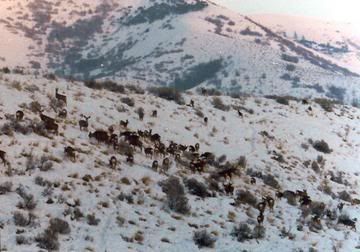Where have all the mule deer gone?
 As recently as 1988, mule deer herds were doing well -in fact, near an all-time population high. Since that time, mule deer have declined and have not recovered. The major cause for the original decline was rooted in the effects of weather. Mule deer herds have always been impacted by weather, but have typically been able to recover quickly from drought or severe winter. Possibly, the worst weather related situation affecting mule deer is when a drought is followed immediately by a severe winter. If there is ever a time to supplement or to call for an emergency hunt, that would be it.
As recently as 1988, mule deer herds were doing well -in fact, near an all-time population high. Since that time, mule deer have declined and have not recovered. The major cause for the original decline was rooted in the effects of weather. Mule deer herds have always been impacted by weather, but have typically been able to recover quickly from drought or severe winter. Possibly, the worst weather related situation affecting mule deer is when a drought is followed immediately by a severe winter. If there is ever a time to supplement or to call for an emergency hunt, that would be it.
In drought, usually associated with heat, mule deer do not forage well. It is essential to mule deer, in most areas, that they build up sufficient fat reserves to see them through winter. In drought conditions, the potential for gaining fat is diminished. During a severe winter, the time will certainly arrive when mule deer expend more calories eating than they derive from what they eat. Just maintaining essential body heat uses valuable calories. At such times, mule deer depend on fat reserves. When those fat reserves are not available, or are insufficient, mule deer get sick and die. When caloric output exceeds caloric intake, it is quite advantageous for mule deer to become sedate; to limit their movement. They will do this if not disturbed too much.
In most of the Western United States, mule deer suffered a difficult winter around 1983. They rebounded very well and very quickly reaching a long-term high around 1988. The intervening years had ample moisture, good forage, relatively mild winters, and limited predation. The winter of 1988 was devastating to mule deer with losses as high as 70% in some areas. It might have been expected that mule deer would have made a full recovery by now, but there are 3 factors that have prevented them from doing so.
First, the number of mule deer predators has steadily increased. Concurrently, the number of mule deer hunters and the percentage of hunter success has suffered tremendously, because there are few surplus deer remaining after predation. Mountain lions were reaching their maximum carrying capacity about the very time when the mule deer were hardest hit. Cougars were protected beginning in 1972 and steadily increased until 1988. Based on population modeling I have done, I believe mountain lion increases were exponential rather than linear. Even though the deer herd dropped quite suddenly by two-thirds, the mountain lion population did not and has not dropped. The single most important factor allowing mountain lions to be unaffected by the mule deer decline is the presence of alternative food sources, particularly the ever increasing elk herds. Another significant factor is the protection that lions have enjoyed. Modern hunting regulations generally do not allow more lions to be harvested than the annual population increase, thus keeping lions at a constant maximum. Lions have expanded to the point where there is scarcely room for more – since they are highly territorial.
Secondly, game managers have insisted on killing does since about 1990. In my estimation, there is no good reason for killing does until or unless herds have exceeded their carrying capacity. As of 2007, overall mule deer numbers are at less than half of carrying capacity. Also, a case can easily be made against killing does for genetic reasons, yet the doe slaughter continues even today. Hunters, not unlike predators, seek to kill the best and healthiest.
Thirdly, game managers have placed limits on the number of mule deer to be allowed. This fact is not always publicized, but is nevertheless true. There are three reasons for the limits: 1) Depredation payments. 2) The belief that mule deer herds had been maintained at artificially high numbers to support hunting, and 3) mule deer are harder to manage than elk – so preference has been given to elk.
Game managers prefer to have us all believe and accept that habitat and weather are the major issues causing mule deer decline because these two “causes” are basically unsolvable and take the focus away from poor management.
The future of mule deer is extremely dependent on what we decide to do with predators. After, or if, we reduce predation to the point where mule deer can again be allowed to increase, then it will be quite appropriate to see what we can do about weather and habitat.
